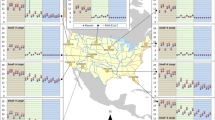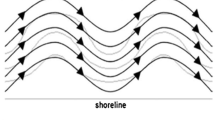Abstract
An investigation of the thermal front in southeastern Lake Michigan during April 1988 revealed a dynamic physical, chemical, and biological environment. The front was observed approximately 4 km from the coast as a distinct gradient separating cold open-lake waters from warmer nearshore waters. Surface isotherms near the front were generally parallel to one another but skewed with respect to shore. Comparison between April 22 and 29 showed that the surface isothern pattern was modulated by wind stress. The pattern from April 29 showed signs of flow instabilities with horizontal scales of 1 km to 5 km. Surface drifter trajectories provided estimates of horizontal convergence at the fron which varied from 7×10−6 s−1 to 20×10−6 s−1. Inferred rates of downwelling, which ranged from 9.5 m d−1 to 20.7 m d−1, were sufficient to move a water parcel from the surface to the bottom in 2 to 6 d at the front. Convergent circulation was observed on both sampling dates despite contrasts in wind stress. Concentrations of chloride, soluble silica, and chlorophyll, which were always higher inshore, were 5% to 82% larger than offshore mean values. The aquatic environment just inshore of the thermal front was characterized by chlorphyll concentrations which exceeded 5.0 μg 1−1 while concentrations offshore were between 1.0 μg 1−1 and 2.0 μg 1−1. A relatively uniform vertical structure in chlorophyll concentrations in the frontal zone was consistent with the observed convergence and inferred downwelling near the front.
Similar content being viewed by others
Literature Cited
Armstrong, F. A., C. R. Stearns, andJ. D. H. Strickland. 1967. The measurement of upwelling and subsequent biological processes by means of the Technicon Autoanalyzer and associated equipment.Deep-Sea Research 14:381–389.
Bennett, J. R. 1971. Thermally driven currents during the spring and fall transition periods, p. 535–544.In Proceedings, 14th Conference Great Lakes Research, International Association for Great Lakes Research. Ann Arbor, Michigan.
Bowers, J. A., R. Rossmann, J. Barres, and W. Y. B. Chang. 1986. Phytoplankton populations of southeast Lake Michigan 1974–1982, p. 141–168.In R. Rossmann (ed.), Impact of the Donald C. Cook Nuclear Plant. University of Michigan, Great Lakes Research Division, Publication number 22. Ann Arbor, Michigan.
Boyce, F. M. 1974. Some aspects of Great Lakes physics of importance to biological and chemical processes.Journal of the Fisheries Research Board of Canada 31:689–730.
Breuer, J. P. 1962. An ecological survey of the Lower Laguna Madre of Texas, 1953–1959.Publications of the Institute of Marine Science, University of Texas 8:153–183.
Chang, W. Y. B. andR. Rossmann. 1988. Changes in the abundance of blue-green algae related to nutrient loadings in the nearshore of Lake Michigan.Hydrobiologia 157:271–278.
Csanady, G. T. 1978. Water circulation and dispersal mechanisms, p. 21–64.In A. Lerman (ed.), LAKES: Chemistry, Geology, Physics. Springer-Verlag, New York.
Davis, C. O., C. L. Schelske, and R. G. Kreis. 1980. Influences of spring nearshore thermal bar, p. 140–164.In C. L. Schelske, R. A. Moll, and M. S. Simmons (eds.), Limnological Conditions in Southern Lake Huron, 1974 and 1975. United States Environmental Protection Agency report number EPA-600/3-80-074.
Franks, P. J. S. 1992. Phytoplankton blooms at fronts: Patterns, scales, and physical forcing mechanisms.Reviews in Aquatic Sciences 6:121–137.
Guillou, J. J., J. P. Debenay, andJ. Pagès. 1987. L'avifaune aquatique de l'estuarie de la Casamance (Sénégal), en amont de Ziguinchor.Revue d'Hydrobiologie Tropicale 20:311–322.
Huang, J. C. K. 1969. The thermal current structure in Lake Michigan—A theoretical and observational model study. Ph.D. Dissertation, The University of Michigan. 169 p.
Huang, J. C. K. 1972. The thermal bar.Geophysical Fluid Dynamics 3:1–25.
Le Reste, L. andO. Collart-Odinetz. 1987. Étude des déplacements de crevettes dans l'estuaire de la Casamance (Sénégal).Revue d'Hydrobiologie Tropicale 20:271–278.
McCormick, M. J., A. H. Clites, andJ. E. Campbell. 1985. Water-tracking ability of satellite-tracked drifters in light winds.Marine Technology Society Journal 19:12–17.
Moll, R. A. andM. Z. Brahce 1986. Seasonal and spatial distribution of bacteria, chlorophyll, and nutrients in nearshore Lake Michigan.Journal of Great Lakes Research 12:52–62.
Moll, R. A., C. O. Davis, andC. L. Schelske. 1980. Phytoplankton productivity and standing crop in the vicinity of the Lake Huron-Saginaw Bay front.Journal of Great Lakes Research 6:232–246.
Moll, R. A., R. Rossmann, J. A. Barres, andF. J. Horvath. 1991. Historical trends of chlorides in the Great Lakes, p. 303–322.In F. M. D'Itri (ed.), Deicing Chemicals and the Environment. Lewis Publishers, Chelsea, Michigan.
Mortimer, C. H. 1988. Discoveries and testable hypotheses arising from coastal zone color scanner imagery of southern Lake Michigan.Limnology and Oceanography 33:203–226.
Okubo, A. 1980. Diffusion and ecological problems: Mathematical models. Springer-Verlag, New York. 254 p.
Pagès, J. andJ.-P. Debenay. 1987. Évolution saisonnière de la salinité de la Casamance. Description et essai de modélisation.Revue d'Hydrobiologie Tropicale 20:203–218.
Pagès, J., J.-P. Debenay, andJ. Y. Le Brusq. 1987. L'environnement estuarien de la Casamance.Revue d'Hydrobiologie Tropicale 20:191–202.
Rodgers, G. K. 1966. The thermal bar in Lake Ontario, spring 1965 and winter 1965–66, p. 369–374.In Proceedings 9th Conference Great Lakes Research, University of Michigan, Great Lakes Research Division Publication number 15. Ann Arbor, Michigan.
Rodgers, G. K. 1968. Heat advection within Lake Ontario in spring and surface water transparency associated with the thermal bar. p. 480–486.In Proceedings 11th Conference Great Lakes Research, International Association for Great Lakes Research. Ann Arbor, Michigan.
Rodgers, G. K. 1987. Time of onset of full thermal stratification in Lake Ontario in relation to lake temperature in winter.Canadian Journal of Fisheries and Aquatic Sciences 44:2225–2229.
Rossmann, R. 1986. Waters of southeastern nearshore Lake Michigan, p. 51–86.In R. Rossmann (ed.), Impact of the Donald C. Cook Nuclear Plant. University of Michigan, Great Lakes Research Division, Publication number 22. Ann Arbor, Michigan.
Rousar, D. C. 1973. Seasonal and spatial changes in primary production and nutrients in Lake Michigan.Water, Air and Soil Pollution 2:497–514.
Saylor, J. H., J. R. Bennett, F. M. Boyce, P. C. Liu, C. R. Murty, R. L. Pickett, andT. J. Simons. 1981. Water movements, p. 247–324.In E. J. Aubert and T. L. Richards (eds.), IFYGL—The International Field Year for the Great Lakes. National Oceanic and Atmospheric Administration, Great Lakes Environmental Research Laboratory, Ann Arbor, Michigan.
Scavia, D. andJ. R. Bennett. 1980. Spring transition period in Lake Ontario—A numerical study of the causes of the large biological and chemical gradients.Canadian Journal of Fisheries and Aquatic Sciences 37:823–833.
Schelske, C. L., L. E. Feldt, and M. S. Simmons. 1980. Phytoplankton and Physical-Chemical Conditions in Selected Rivers and the Coastal Zone of Lake Michigan, 1972. University of Michigan, Great Lakes Research Division, Publication number 19. Ann Arbor, Michigan.
Stoermer, E. F. 1968. Nearshore phytoplankton populations in the Grand Haven, Michigan vicinity during thermal bar condition. p. 137–150.In Proceedings 11th Conference Great Lakes Research, International Association for Great Lakes Research. Ann Arbor, Michigan.
Strickland, J. D. H. and T. R. Parsons. 1972. A practical handbook of seawater analysis. Fisheries Research Board of Canada Bulletin 167.
Tikhomirov, A. I. 1963. The thermal bar of Lake Ladoga.Bulletin (Izvestiya) All-Union Geographical Society 95:134–142. American Geophysical Union Translation, Soviet Hydrology: Selected Papers Number 2.
United States Environmental Protection Agency. 1976. Manual of Methods for Chemical Analysis of Water and Wastes. Office of Technology Transfer, Cincinnati, Ohio.
Wolanski, E. 1988. Circulation anomalies in tropical Australian estuaries, p. 53–60.In B. Kjerfve (ed.), Hydrodynamics of Estuaries, Vol. II. CRC Press, Inc., Boca Raton, Florida.
Zilitinkevich, S. S., K. D. Kreiman, andA. Y. Terzhevik. 1992. The thermal bar.Journal of Fluid Mechanics 236:27–42.
Author information
Authors and Affiliations
Rights and permissions
About this article
Cite this article
Moll, R.A., Bratkovich, A., Chang, W.Y.B. et al. Physical, chemical, and biological conditions associated with the early stages of the Lake Michigan vernal thermal front. Estuaries 16, 92–103 (1993). https://doi.org/10.2307/1352767
Received:
Accepted:
Issue Date:
DOI: https://doi.org/10.2307/1352767




